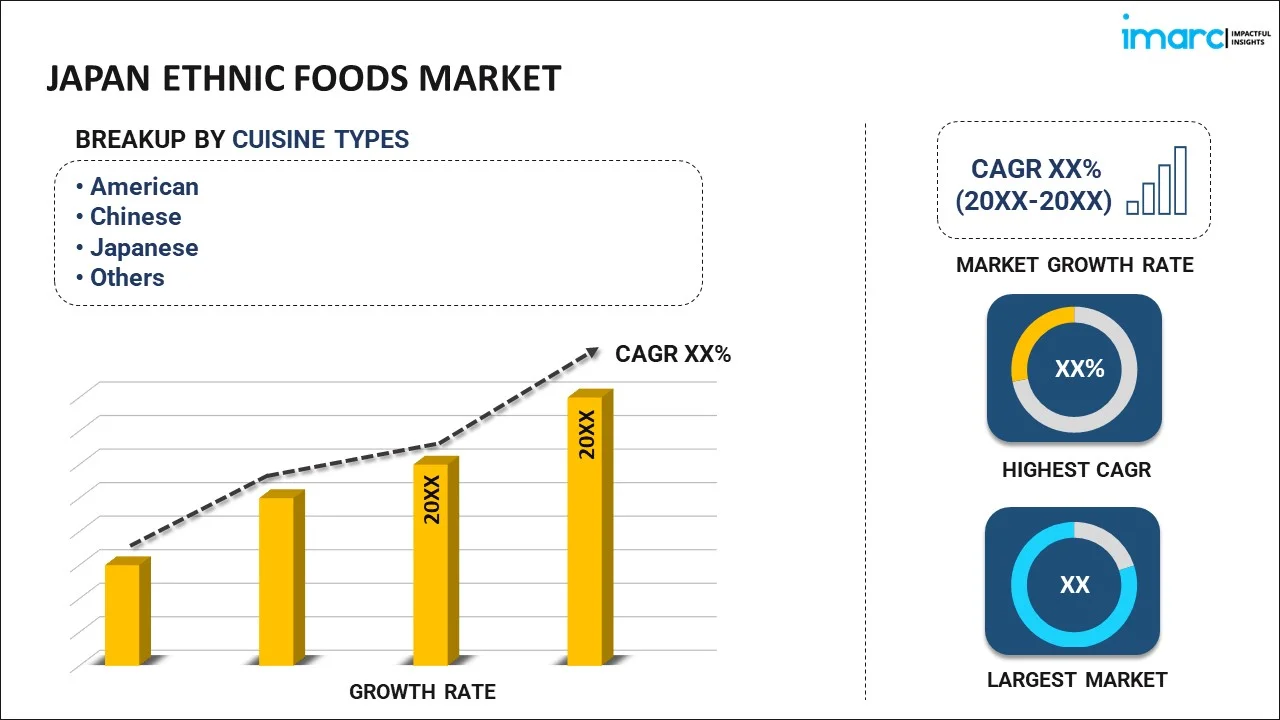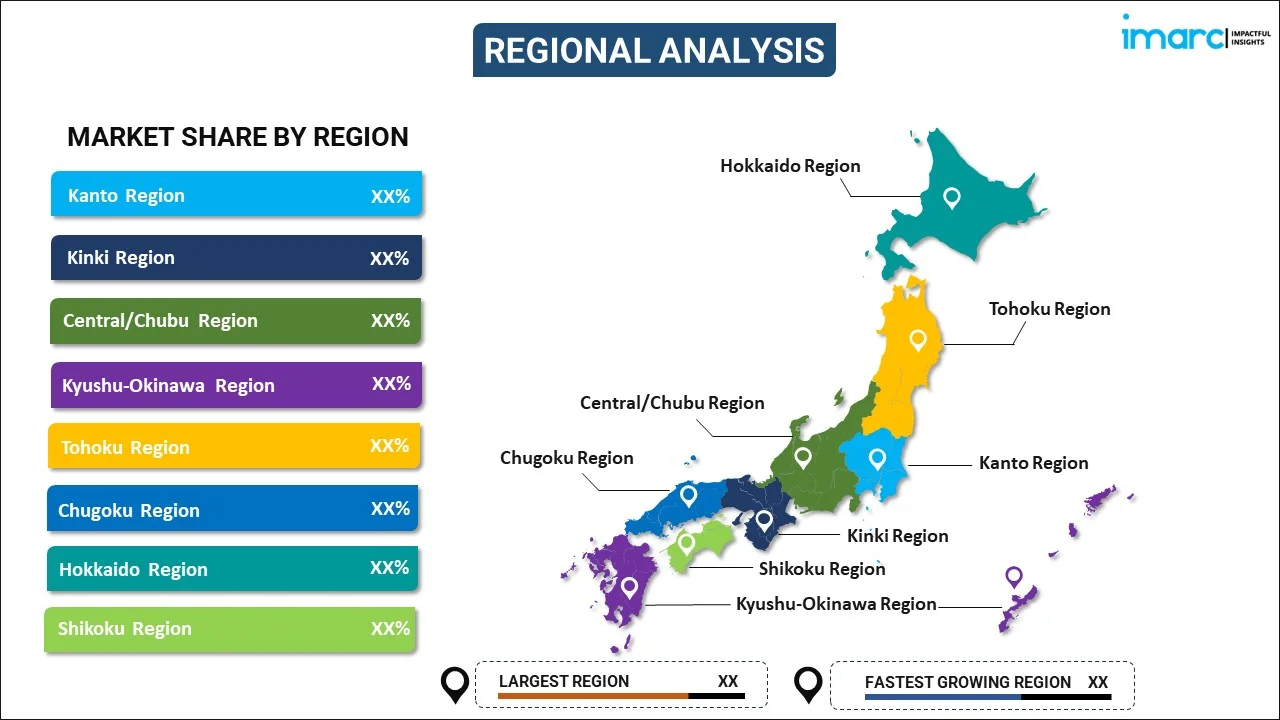
Japan Ethnic Foods Market Report by Cuisine Type (American, Chinese, Japanese, Mexican, Italian, and Others), Food Type (Vegetarian, Non-Vegetarian), Distribution Channel (Food Services, Retail Stores), and Region 2025-2033
Market Overview:
The Japan ethnic foods market size reached USD 3.0 Billion in 2024. Looking forward, IMARC Group expects the market to reach USD 6.4 Billion by 2033, exhibiting a growth rate (CAGR) of 8.2% during 2025-2033. The increasing globalization of culinary culture, the changing demographics in Japan, escalating health consciousness, implementation of various initiatives by the Government of Japan, recent advancements in food technology, and rising food-themed tourism in Japan represent some of the key factors driving the market.
|
Report Attribute
|
Key Statistics
|
|---|---|
|
Base Year
|
2024 |
|
Forecast Years
|
2025-2033
|
|
Historical Years
|
2019-2024
|
| Market Size in 2024 | USD 3.0 Billion |
| Market Forecast in 2033 | USD 6.4 Billion |
| Market Growth Rate (2025-2033) | 8.2% |
Ethnic foods refer to culinary creations that represent specific cultures or geographical regions. They are marked by their specialized cooking methods, flavors, and customary ingredients. It includes American, Mexican, Japanese, Chinese, Persian, Arabian, Indian, Italian, and Mediterranean, each differentiated by its unique taste, texture, and aesthetic qualities. Ethnic foods are prepared using various ingredients, such as herbs, spices, pickles, cheese, lentils, fish, meats, rice, beans, mushrooms, vegetable oils, sauces, bread, and dairy products. They offer a rich nutritional profile comprising carbohydrates, vitamins, dietary fibers, proteins, health-beneficial fats, antioxidants, omega-3 fatty acids, and vital minerals, such as potassium, calcium, iron, magnesium, and zinc. They are an integral part of daily meals, holiday festivities, cultural events, hospitality services, packaged food offerings, culinary tourism, avant-garde fusion cuisine, and specialized dining establishments. Ethnic foods aid in preserving cultural identity, broadening culinary horizons, catering to a variety of taste preferences, fostering culinary innovation, and enhancing gastronomical experiences.
Japan Ethnic Foods Market Trends:
The increasing globalization of culinary culture, which is exposing Japanese consumers to a wide variety of ethnic foods, is propelling the market growth. Along with this, the demographic shifts in Japan, including the rise in international tourism and the presence of expatriate communities, are contributing to the market growth. Furthermore, the escalating health consciousness among Japanese consumers is facilitating the demand for ethnic foods owing to their nutritional value comprising essential vitamins, fibers, and healthy fats. Besides this, the recent advancements in food technologies, which are enabling the production, packaging, and distribution of ethnic foods on a broader scale, thus making ethnic ingredients and ready-to-eat (RTE) meals more accessible to Japanese consumers, are boosting the market growth. Apart from this, the rapid proliferation of specialty restaurants, food trucks, and gourmet markets that specialize in ethnic foods is positively influencing the market growth. Moreover, the implementation of various initiatives by the Government of Japan promoting cultural diversity and international relationships is catalyzing the market growth. In addition, the rising food-themed tourism in Japan, where travelers seek authentic and diverse culinary experiences, is favoring the market growth. Along with this, the increasing utilization of online platforms for food delivery and e-commerce, which is making ethnic foods readily accessible to a wider audience, is fueling the market growth. Furthermore, the growing collaborations between local producers and international chefs leading to innovative fusion cuisines are strengthening the market growth.
Japan Ethnic Foods Market Segmentation:
IMARC Group provides an analysis of the key trends in each segment of the Japan ethnic foods market report, along with forecasts at the country level for 2025-2033. Our report has categorized the market based on cuisine type, food type, and distribution channel.
Cuisine Type Insights:

- American
- Chinese
- Japanese
- Mexican
- Italian
- Others
The report has provided a detailed breakup and analysis of the market based on the cuisine type. This includes American, Chinese, Japanese, Mexican, Italian, and others.
Food Type Insights:
- Vegetarian
- Non-Vegetarian
A detailed breakup and analysis of the market based on the food type has also been provided in the report. This includes vegetarian and non-vegetarian.
Distribution Channel Insights:
- Food Services
- Retail Stores
A detailed breakup and analysis of the market based on the distribution channel has also been provided in the report. This includes food services and retail stores.
Regional Insights:

- Kanto Region
- Kinki Region
- Central/Chubu Region
- Kyushu-Okinawa Region
- Tohoku Region
- Chugoku Region
- Hokkaido Region
- Shikoku Region
The report has also provided a comprehensive analysis of all the major regional markets, which include Kanto Region, Kinki Region, Central/Chubu Region, Kyushu-Okinawa Region, Tohoku Region, Chugoku Region, Hokkaido Region, and Shikoku Region.
Competitive Landscape:
The report has also provided a comprehensive analysis of the competitive landscape in the market. Competitive analysis such as market structure, key player positioning, top winning strategies, competitive dashboard, and company evaluation quadrant has been covered in the report. Also, detailed profiles of all major companies have been provided.
Japan Ethnic foods Market Report Coverage:
| Report Features | Details |
|---|---|
| Base Year of the Analysis | 2024 |
| Historical Period | 2019-2024 |
| Forecast Period | 2025-2033 |
| Units | Billion USD |
| Scope of the Report | Exploration of Historical and Forecast Trends, Industry Catalysts and Challenges, Segment-Wise Historical and Predictive Market Assessment:
|
| Cuisine Types Covered | American, Chinese, Japanese, Mexican, Italian, Others |
| Food Types Covered | Vegetarian, Non-Vegetarian |
| Distribution Channels Covered | Food Services, Retail Stores |
| Regions Covered | Kanto Region, Kinki Region, Central/Chubu Region, Kyushu-Okinawa Region, Tohoku Region, Chugoku Region, Hokkaido Region, Shikoku Region |
| Customization Scope | 10% Free Customization |
| Post-Sale Analyst Support | 10-12 Weeks |
| Delivery Format | PDF and Excel through Email (We can also provide the editable version of the report in PPT/Word format on special request) |
Key Questions Answered in This Report:
- How has the Japan ethnic foods market performed so far and how will it perform in the coming years?
- What has been the impact of COVID-19 on the Japan ethnic foods market?
- What is the breakup of the Japan ethnic foods market on the basis of cuisine type?
- What is the breakup of the Japan ethnic foods market on the basis of food type?
- What is the breakup of the Japan ethnic foods market on the basis of distribution channel?
- What are the various stages in the value chain of the Japan ethnic foods market?
- What are the key driving factors and challenges in the Japan ethnic foods market?
- What is the structure of the Japan ethnic foods market and who are the key players?
- What is the degree of competition in the Japan ethnic foods market?
Key Benefits for Stakeholders:
- IMARC’s report offers a comprehensive quantitative analysis of various market segments, historical and current market trends, market forecasts, and dynamics of the Japan ethnic foods market from 2019-2033.
- The research study provides the latest information on the market drivers, challenges, and opportunities in the Japan ethnic foods market.
- Porter's five forces analysis assist stakeholders in assessing the impact of new entrants, competitive rivalry, supplier power, buyer power, and the threat of substitution. It helps stakeholders to analyze the level of competition within the Japan ethnic foods industry and its attractiveness.
- Competitive landscape allows stakeholders to understand their competitive environment and provides an insight into the current positions of key players in the market.
Need more help?
- Speak to our experienced analysts for insights on the current market scenarios.
- Include additional segments and countries to customize the report as per your requirement.
- Gain an unparalleled competitive advantage in your domain by understanding how to utilize the report and positively impacting your operations and revenue.
- For further assistance, please connect with our analysts.

 Inquire Before Buying
Inquire Before Buying
 Speak to an Analyst
Speak to an Analyst
 Request Brochure
Request Brochure
 Request Customization
Request Customization



.webp)




.webp)












